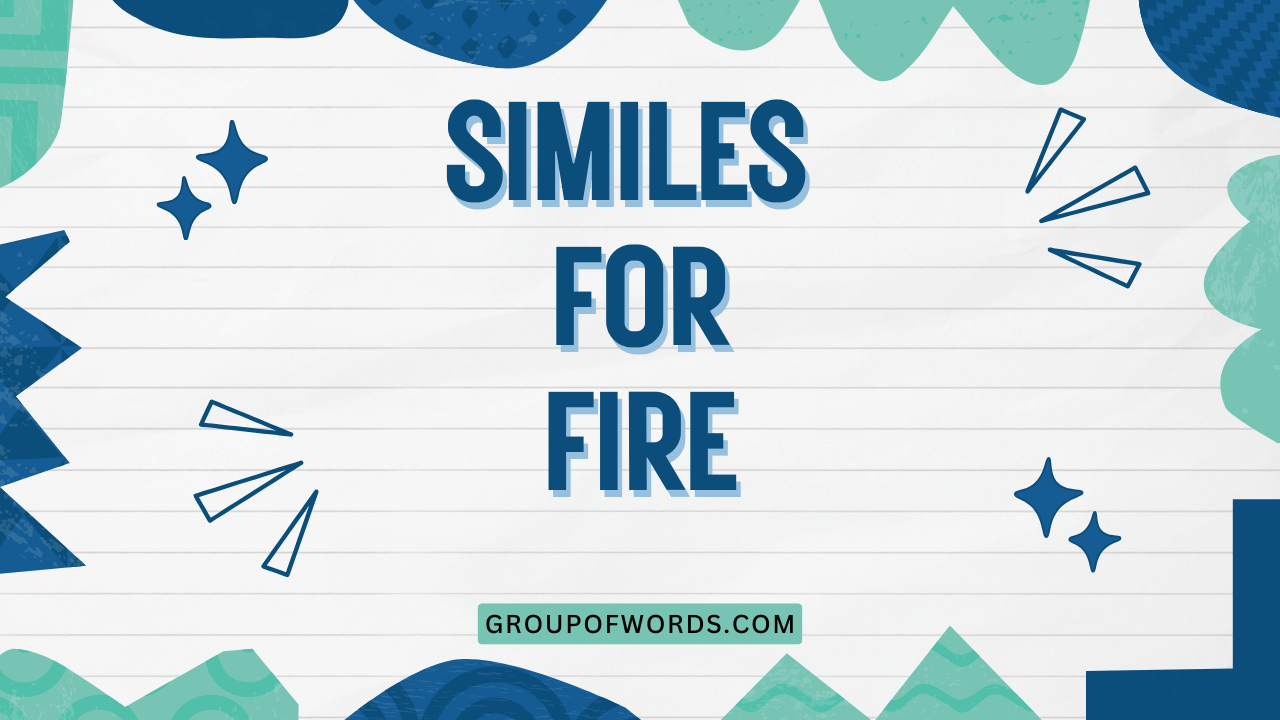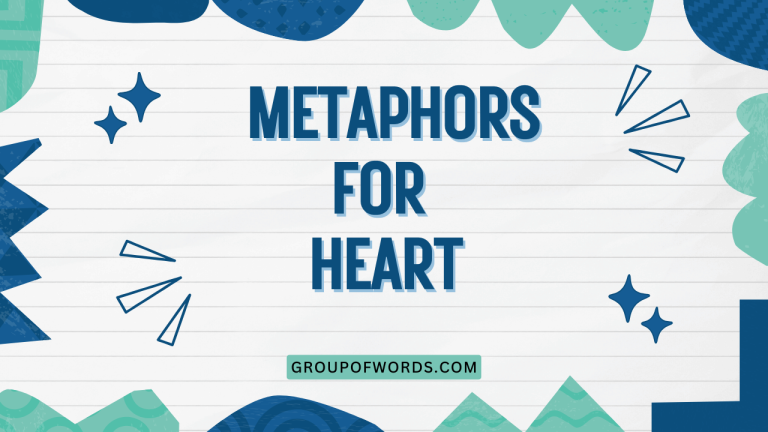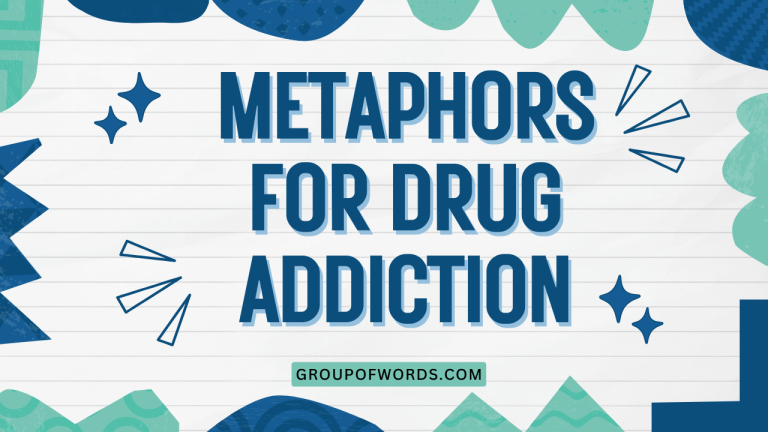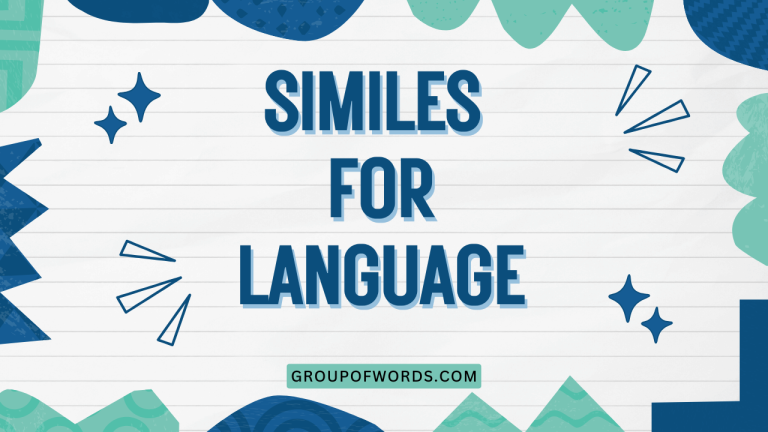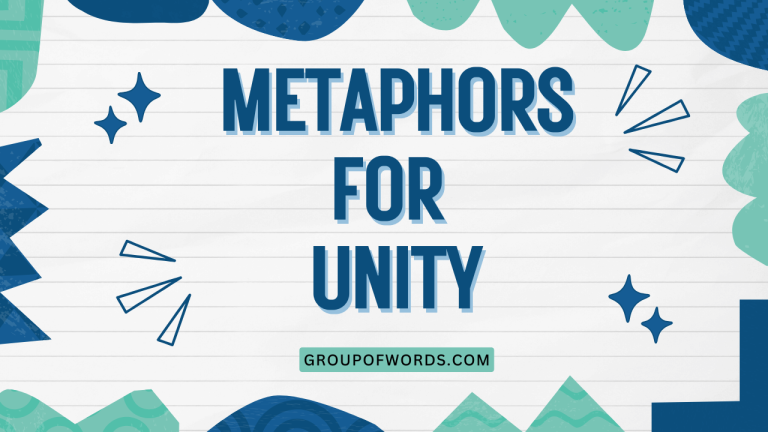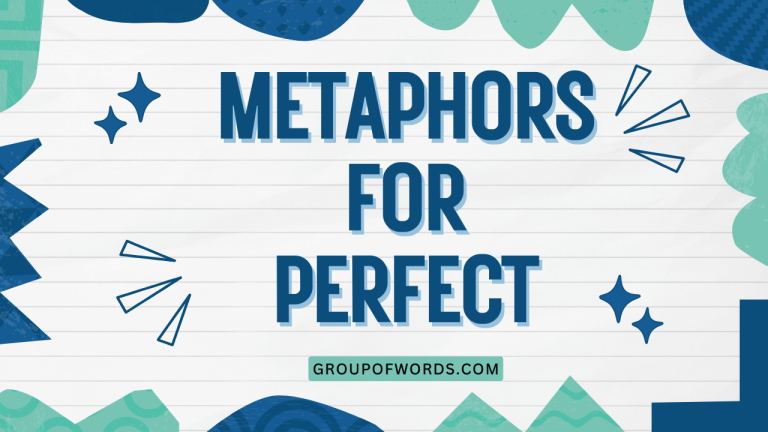Similes for Fire: Igniting Your Language Skills
Similes are powerful tools that enhance our writing and speaking by drawing vivid comparisons. Understanding how to use similes effectively, especially when describing something as dynamic and multifaceted as fire, can significantly improve your descriptive abilities.
This article provides a comprehensive guide to using similes for fire, covering everything from basic definitions to advanced applications. This resource is designed for students, writers, and anyone looking to expand their vocabulary and improve their command of the English language.
By exploring various simile structures and examples, you’ll learn to create more engaging and impactful descriptions. Mastering similes will not only enrich your writing but also sharpen your analytical skills, enabling you to appreciate the nuances of language and its ability to paint compelling mental images.
Let’s delve into the world of similes and discover how they can bring the essence of fire to life through words.
Table of Contents
- Definition of Simile
- Structural Breakdown of Similes
- Types of Similes
- Examples of Similes for Fire
- Usage Rules for Similes
- Common Mistakes with Similes
- Practice Exercises
- Advanced Topics: Metaphor vs. Simile
- Frequently Asked Questions
- Conclusion
Definition of Simile
A simile is a figure of speech that directly compares two different things using the words “like” or “as.” The purpose of a simile is to create a vivid image or to emphasize a particular quality of one thing by associating it with something else that is familiar or easily understood. Similes are essential tools in descriptive writing and poetry, adding depth and color to the text.
In essence, a simile asserts a similarity between two otherwise dissimilar entities. This comparison helps the reader or listener to perceive the subject in a new and often more impactful way.
The effectiveness of a simile lies in the strength and relevance of the comparison. A well-chosen simile can transform a mundane description into something memorable and engaging.
For example, instead of simply saying “the fire was hot,” a simile might say “the fire was as hot as the sun,” immediately conveying a more intense and impactful image.
Similes are often contrasted with metaphors, which also draw comparisons but do so implicitly, without using “like” or “as.” While a simile states that something is like something else, a metaphor states that something is something else. This direct assertion in a metaphor makes it a stronger, but potentially less nuanced, form of comparison.
Structural Breakdown of Similes
Similes typically follow a straightforward structure, which makes them relatively easy to identify and construct. The basic formula for a simile is: A is like/as B. Here, ‘A’ is the subject being described, and ‘B’ is the object to which it is being compared. The words “like” or “as” serve as the bridge connecting the two elements.
Let’s break down the components:
- Subject (A): This is the noun or pronoun that you are describing. For example, in the simile “The fire was as bright as the sun,” the subject is “the fire.”
- Connecting Word (like/as): These words are crucial indicators that you are using a simile rather than a metaphor. They explicitly state the comparison.
- Object of Comparison (B): This is the noun or pronoun to which the subject is being compared. In the example above, the object of comparison is “the sun.”
The effectiveness of a simile also depends on the shared characteristic between the subject and the object of comparison. This shared characteristic should be relevant and contribute to a better understanding or appreciation of the subject.
For instance, comparing fire to the sun highlights its brightness and intensity.
Here’s a table illustrating the structural breakdown with more examples:
| Simile | Subject (A) | Connecting Word | Object of Comparison (B) | Shared Characteristic |
|---|---|---|---|---|
| The fire roared like a hungry lion. | The fire | like | a hungry lion | Loudness, ferocity |
| The flames danced as gracefully as a ballerina. | The flames | as | a ballerina | Graceful movement |
| The embers glowed like rubies. | The embers | like | rubies | Color, brilliance |
| The fire spread as quickly as gossip. | The fire | as | gossip | Rapid spread |
| The heat was like a physical blow. | The heat | like | a physical blow | Intensity, impact |
Types of Similes
While all similes share the basic structure of comparing two things using “like” or “as,” they can be categorized based on the type of comparison they make or the effect they create. Here are a few types of similes:
Descriptive Similes
These similes focus on describing a physical attribute or characteristic of the subject. They help the reader visualize or understand the subject more clearly.
For example, “The fire was as red as blood” is a descriptive simile that emphasizes the color of the fire.
Emotive Similes
These similes evoke an emotional response in the reader by comparing the subject to something that carries a strong emotional connotation. For example, “The fire felt like a warm embrace” uses the feeling of a warm embrace to convey a sense of comfort and security associated with the fire.
Figurative Similes
These similes use abstract or less literal comparisons to create a more imaginative or thought-provoking effect. They often require the reader to make a deeper connection between the subject and the object of comparison.
For example, “The fire’s energy was like a wild spirit” compares the fire’s energy to a wild spirit, suggesting untamed and unpredictable nature.
Hyperbolic Similes
These similes use exaggeration to emphasize a particular quality of the subject. They are not meant to be taken literally but rather to create a strong impression.
For example, “The fire was as hot as the center of the earth” is a hyperbolic simile that exaggerates the fire’s heat to an extreme degree.
Understated Similes
In contrast to hyperbolic similes, these use understatement to create a subtle or ironic effect. They might compare something intense to something seemingly insignificant.
For example, “The fire was as concerning as a slightly burnt toast” downplays the potential danger of the fire.
Examples of Similes for Fire
Fire is a versatile subject for similes due to its many qualities: its intensity, movement, color, sound, and effects. Here are numerous examples, categorized by these aspects, to illustrate how similes can be used to describe fire in various ways.
Similes Describing Fire’s Intensity
These similes focus on the heat, power, and strength of the fire. They help convey how intense and forceful the fire is.
Below are some examples of similes that describe fire’s intensity, followed by a table of 25 different examples.
Example: “The fire burned as fiercely as a dragon’s breath.” This simile uses the image of a dragon’s breath to emphasize the intense heat and power of the fire.
Example: “The heat from the fire was like standing in front of a furnace.” This simile compares the fire’s heat to that of a furnace, highlighting its extreme intensity.
| Simile |
|---|
| The fire burned as fiercely as a dragon’s breath. |
| The heat from the fire was like standing in front of a furnace. |
| The fire roared as powerfully as a volcano erupting. |
| The flames licked at the wood like a starving beast. |
| The fire’s intensity was like the sun’s surface. |
| The blaze consumed everything as relentlessly as a wildfire. |
| The heat was as oppressive as a desert sun. |
| The fire burned with the intensity of a thousand suns. |
| Its heat felt like a physical blow. |
| The flames rose as aggressively as an army charging. |
| The fire was as scorching as molten lava. |
| The heat radiated like waves from a blacksmith’s forge. |
| It burned as hot as Hades itself. |
| The fire’s force was like a battering ram against the door. |
| The heat was as unbearable as being trapped in an oven. |
| The fire devoured the forest as ruthlessly as a conquering army. |
| The blaze raged like an inferno unleashed. |
| The flames were as intense as a welder’s torch. |
| The fire was as consuming as a black hole. |
| The heat pounded like a blacksmith’s hammer. |
| The fire was as aggressive as a cornered animal. |
| The flames rose like the wrath of a god. |
| The fire’s intensity felt like a branding iron on skin. |
| The heat was as searing as a blast furnace. |
| It burned with the fury of a thousand storms. |
Similes Describing Fire’s Movement
These similes capture the way fire moves, whether it’s dancing, spreading, or flickering. They add a dynamic quality to the description.
Below are some examples of similes that describe fire’s movement, followed by a table of 25 different examples.
Example: “The flames danced like playful spirits.” This simile uses the image of playful spirits to convey the lively and erratic movement of the flames.
Example: “The fire spread as quickly as gossip.” This simile compares the rapid spread of fire to the rapid spread of gossip, emphasizing its swift and uncontrollable movement.
| Simile |
|---|
| The flames danced like playful spirits. |
| The fire spread as quickly as gossip. |
| The fire flickered like a nervous heartbeat. |
| The flames writhed like snakes in a pit. |
| The fire crept along the forest floor like a predator stalking its prey. |
| The flames leapt and jumped as if mocking the night. |
| The fire advanced like a slow, relentless tide. |
| The embers glowed and pulsed like living organisms. |
| The flames swayed like dancers in a trance. |
| The fire twisted and turned like a tormented soul. |
| The smoke billowed like a dark genie escaping its bottle. |
| The flames surged forward as if propelled by an unseen force. |
| The fire moved through the dry grass like a hot knife through butter. |
| The flames fluttered like the wings of a trapped bird. |
| The fire snaked its way up the tree trunk like an eager climber. |
| The flames reached out like grasping hands. |
| The fire cascaded down the hillside like a molten waterfall. |
| The flames darted back and forth like lightning bugs. |
| The fire flowed like a river of destruction. |
| The flames jumped and skipped like excited children. |
| The fire rose and fell like a breathing dragon. |
| The embers shifted like secrets whispered in the dark. |
| The flames coiled like springs ready to unleash. |
| The fire crept and crawled like a devious intruder. |
| The flames chased each other like playful puppies. |
Similes Describing Fire’s Color
These similes focus on the visual aspect of fire, highlighting its various colors, from bright reds and oranges to deep blues and purples. They help create a visually rich description.
Below are some examples of similes that describe fire’s color, followed by a table of 25 different examples.
Example: “The embers glowed like rubies.” This simile uses the image of rubies to emphasize the deep red color of the embers.
Example: “The flames were as orange as a sunset.” This simile compares the color of the flames to the warm orange hues of a sunset, creating a vivid visual image.
| Simile |
|---|
| The embers glowed like rubies. |
| The flames were as orange as a sunset. |
| The fire burned as red as blood. |
| The flames danced with colors like a peacock’s feathers. |
| The heart of the fire was as white as a star. |
| The flames flickered with hues like a painter’s palette. |
| The fire’s glow was as golden as autumn leaves. |
| The edges of the flames were as blue as a summer sky. |
| The fire shimmered with colors like an opal. |
| The flames were as vibrant as a field of poppies. |
| The fire burned with a yellow hue like a ripe lemon. |
| The flames pulsed with shades like a nebula. |
| The fire’s intensity was as white-hot as a welding arc. |
| The flames rippled with colors like gasoline on water. |
| The fire burned a deep crimson like aged wine. |
| The flames glowed with a purple tint like amethyst. |
| The fire’s embers sparked like tiny diamonds. |
| The flames shimmered with an ethereal glow like moonlight. |
| The fire burned with a fiery orange like a tiger’s stripes. |
| The flames danced with iridescent colors like a soap bubble. |
| The fire pulsed with a vibrant red like a beating heart. |
| The flames flickered with a mysterious blue like deep water. |
| The fire burned with a fierce yellow like a canary’s feathers. |
| The flames swirled with colors like a kaleidoscope. |
| The fire’s glow was as warm and inviting as candlelight. |
Similes Describing Fire’s Sound
These similes focus on the sounds produced by fire, such as crackling, roaring, and hissing. They add an auditory dimension to the description.
Below are some examples of similes that describe fire’s sound, followed by a table of 25 different examples.
Example: “The fire crackled like dry leaves underfoot.” This simile compares the sound of the fire to the sound of dry leaves being crushed, creating a familiar and evocative auditory image.
Example: “The fire roared like a hungry lion.” This simile compares the loud, powerful sound of the fire to the roar of a lion, emphasizing its intensity and ferocity.
| Simile |
|---|
| The fire crackled like dry leaves underfoot. |
| The fire roared like a hungry lion. |
| The fire hissed like an angry snake. |
| The flames whispered like secrets in the night. |
| The fire snapped and popped like a string of firecrackers. |
| The blaze thundered like a waterfall. |
| The fire murmured like a contented sleeper. |
| The flames sighed like a weary traveler. |
| The fire screeched like metal grinding against metal. |
| The blaze boomed like a distant cannon. |
| The fire chuckled like a mischievous imp. |
| The flames chattered like teeth in the cold. |
| The fire rumbled like a slumbering giant. |
| The flames rustled like silk in a breeze. |
| The fire howled like a winter wind. |
| The flames sang like a choir of destruction. |
| The fire grumbled like an old man complaining. |
| The flames whispered like a ghost’s lament. |
| The fire roared like a freight train passing. |
| The flames snapped like twigs underfoot. |
| The fire crackled like static on the radio. |
| The flames sighed like leaves falling in autumn. |
| The fire hissed like steam escaping a kettle. |
| The flames murmured like a lullaby of ruin. |
| The fire thrummed like a drumbeat of destruction. |
Similes Describing Fire’s Effect
These similes focus on the impact and consequences of fire, such as its destructive power or its ability to provide warmth and light. They help convey the broader significance of the fire.
Below are some examples of similes that describe fire’s effect, followed by a table of 25 different examples.
Example: “The fire consumed everything as relentlessly as a wildfire.” This simile emphasizes the destructive power of the fire by comparing it to a wildfire that leaves nothing in its wake.
Example: “The warmth of the fire was like a comforting embrace.” This simile highlights the positive effect of the fire, comparing its warmth to a comforting embrace that provides security and solace.
| Simile |
|---|
| The fire consumed everything as relentlessly as a wildfire. |
| The warmth of the fire was like a comforting embrace. |
| The fire’s destruction was like a storm sweeping through. |
| The light from the fire was like a beacon in the darkness. |
| The fire’s effect was as transformative as a phoenix rising from ashes. |
| The warmth spread like a comforting secret. |
| The devastation was as complete as a battlefield. |
| The fire’s glow was like hope in a hopeless place. |
| The destruction unfolded like a nightmare. |
| The warmth enveloped them like a protective shield. |
| Its consuming power was as absolute as a tyrant’s rule. |
| The fire’s presence was like a guardian against the cold. |
| The impact was as sudden as a thunderclap. |
| The warmth radiated like a mother’s love. |
| The damage was as extensive as a hurricane’s aftermath. |
| The fire’s influence was like a spell cast over the land. |
| The fear spread like wildfire through the crowd. |
| The comfort was as soothing as a gentle breeze. |
| The transformation was as drastic as winter turning to spring. |
| The fire’s legacy was like a scar on the landscape. |
| The destruction was as thorough as a plague’s devastation. |
| The warmth was as inviting as a sunny day. |
| The impact was as profound as a life-changing event. |
| The fire’s mark was like an indelible stain. |
| The comfort it provided was like a long-awaited reunion. |
Usage Rules for Similes
Using similes effectively involves understanding and following certain rules to ensure clarity and impact. Here are some key usage rules to keep in mind:
- Ensure a Clear Comparison: The comparison should be easily understandable. The reader should be able to grasp the connection between the subject and the object of comparison without needing to overthink it.
- Use Relevant Comparisons: The object of comparison should share a relevant characteristic with the subject. The shared characteristic should contribute to a better understanding or appreciation of the subject.
- Avoid Clichés: Try to avoid overused similes that have lost their impact due to overuse. Strive for originality and creativity in your comparisons.
- Maintain Consistency: Ensure that the simile fits the tone and style of your writing. The comparison should be consistent with the overall context and purpose of your text.
- Be Specific: Vague similes can be ineffective. The more specific you are in your comparison, the more vivid and impactful your simile will be.
Here’s a table illustrating these rules with examples:
| Rule | Correct Example | Incorrect Example | Explanation |
|---|---|---|---|
| Ensure a Clear Comparison | The fire was as bright as the sun. | The fire was like a feeling. | The first example clearly compares the fire’s brightness to the sun’s. The second is too vague. |
| Use Relevant Comparisons | The fire roared like a hungry lion. | The fire was as quiet as a mouse. | The first example relates to the loud sound of fire. The second is contradictory. |
| Avoid Clichés | The flames danced like playful spirits. | The fire burned like hell. | The first example is more original. The second is a common, overused simile. |
| Maintain Consistency | (In a serious tone) The fire spread as relentlessly as a conquering army. | (In a serious tone) The fire was as fun as a party. | The first example is consistent with a serious tone. The second is incongruous. |
| Be Specific | The embers glowed like rubies in the dark. | The fire was like a jewel. | The first example is more specific, creating a clearer image. The second is too general. |
Common Mistakes with Similes
Even with a good understanding of similes, it’s easy to make mistakes. Recognizing these common errors can help you avoid them and use similes more effectively:
- Confusing Similes with Metaphors: The most common mistake is using a metaphor when a simile is intended, or vice versa. Remember that similes use “like” or “as,” while metaphors make a direct comparison without these words.
- Creating Illogical Comparisons: The comparison should make sense. Avoid comparing things that have no logical connection or shared characteristic.
- Using Too Many Similes: Overusing similes can make your writing feel cluttered and distracting. Use them sparingly and only when they add significant value.
- Using Ineffective Similes: A simile should enhance the description, not weaken it. If the comparison doesn’t add anything meaningful, it’s better to omit it.
- Mixing Tenses: Ensure that the tense of the simile is consistent with the tense of the surrounding text.
Here’s a table highlighting these mistakes with corrections:
| Mistake | Incorrect Example | Correct Example | Explanation |
|---|---|---|---|
| Confusing Similes with Metaphors | The fire was a hungry lion. | The fire roared like a hungry lion. | The first example is a metaphor; the second is a simile. |
| Creating Illogical Comparisons | The fire was as blue as a banana. | The fire was as blue as a gas flame. | The first example is illogical. The second makes a sensible comparison. |
| Using Too Many Similes | The fire was like a dragon, fierce as a storm, and hot as the sun. | The fire was as fierce as a storm. | The first example is cluttered. The second is concise and impactful. |
| Using Ineffective Similes | The fire was like something. | The fire was like a beacon in the darkness. | The first example is vague. The second adds meaningful description. |
| Mixing Tenses | The fire is like a storm that raged. | The fire is like a storm that rages. | The first example mixes tenses. The second is consistent. |
Practice Exercises
Test your understanding of similes with these exercises. Identify the similes in each sentence and explain what is being compared.
For the second exercise, complete the sentences with appropriate similes.
Exercise 1: Identifying Similes
Identify the similes in the following sentences and explain what two things are being compared.
| Question | Answer |
|---|---|
| 1. The fire burned as hot as the desert sun. | Simile: “as hot as the desert sun.” Comparison: The fire’s heat is compared to the heat of the desert sun. |
| 2. The flames danced like playful spirits in the night. | Simile: “like playful spirits.” Comparison: The movement of the flames is compared to the movements of playful spirits. |
| 3. The embers glowed like rubies scattered on black velvet. | Simile: “like rubies scattered on black velvet.” Comparison: The color and appearance of the embers are compared to rubies on black velvet. |
| 4. The fire spread as quickly as a rumor through the town. | Simile: “as quickly as a rumor.” Comparison: The speed of the fire’s spread is compared to the speed of a rumor spreading. |
| 5. The heat from the fire was like a warm embrace on a cold day. | Simile: “like a warm embrace.” Comparison: The feeling of the fire’s heat is compared to the feeling of a warm embrace. |
| 6. The fire crackled like a thousand tiny voices whispering secrets. | Simile: “like a thousand tiny voices whispering secrets.” Comparison: The sound of the fire is compared to voices whispering secrets. |
| 7. The smoke billowed like a dark cloud rising to the sky. | Simile: “like a dark cloud rising to the sky.” Comparison: The appearance of the smoke is compared to a dark cloud. |
| 8. The fire’s intensity was as fierce as a dragon’s rage. | Simile: “as fierce as a dragon’s rage.” Comparison: The intensity of the fire is compared to the rage of a dragon. |
| 9. The flames leapt and jumped like excited children at a party. | Simile: “like excited children at a party.” Comparison: The movement of the flames is compared to the movement of excited children. |
| 10. The fire consumed the forest as relentlessly as time devours all. | Simile: “as relentlessly as time devours all.” Comparison: The fire’s destructive power is compared to the relentless nature of time. |
Exercise 2: Completing Similes
Complete the following sentences by adding an appropriate simile.
| Question | Answer |
|---|---|
| 1. The fire burned __________ . | The fire burned as brightly as a lighthouse. |
| 2. The flames danced __________ . | The flames danced like ribbons in the wind. |
| 3. The embers glowed __________ . | The embers glowed like fireflies in the dark. |
| 4. The fire spread __________ . | The fire spread as rapidly as a virus. |
| 5. The heat from the fire was __________ . | The heat from the fire was like a furnace blasting heat. |
| 6. The sound of the fire was __________ . | The sound of the fire was like a chorus of pops and crackles. |
| 7. The light from the fire was __________ . | The light from the fire was like a warm and welcoming hug. |
| 8. The fire’s destruction was __________ . | The fire’s destruction was as total as a scorched wasteland. |
| 9. The warmth of the fire felt __________ . | The warmth of the fire felt like a gentle sunbeam on my face. |
| 10. The fire seemed to grow __________ . | The fire seemed to grow as wild as an untamed beast. |
Advanced Topics: Metaphor vs. Simile
While similes and metaphors both create comparisons, they differ in their directness. Similes use “like” or “as” to explicitly state the comparison, whereas metaphors imply the comparison by stating that one thing is another.
Simile: The fire is like a dragon. (explicit comparison)
Metaphor: The fire is a dragon. (implied comparison)
Metaphors can be more powerful because they assert a direct equivalence, but they also require more care to ensure the comparison is clear and effective. Similes, on the other hand, are generally easier to understand because they explicitly state the comparison.
Another advanced technique involves using extended similes or metaphors, where the comparison is developed over several sentences or even paragraphs. This can create a more detailed and nuanced image in the reader’s mind.
Consider this example:
Extended Simile: The fire was like a living beast, hungrily devouring everything in its path. Its flames danced and writhed like the limbs of a tormented creature, reaching out to grasp and consume whatever they could find. The heat radiated from it like the breath of a dragon, scorching the earth and driving back all who dared to approach.
This extended simile creates a more vivid and impactful image of the fire by developing the comparison over multiple sentences.
Frequently Asked Questions
Here are some frequently asked questions about similes:
- What is the difference between a simile and a metaphor?
A simile compares two things using “like” or “as,” while a metaphor directly equates two things without using those words. Similes are more explicit, while metaphors are more implicit.
- Why are similes important in writing?
Similes add vividness, clarity, and depth to writing. They help readers visualize and understand concepts by comparing them to familiar things, making the text more engaging and memorable.
- How can I avoid using clichés in my similes?
To avoid clichés, try to think of original and unexpected comparisons. Consider the specific qualities you want to highlight and brainstorm unique objects or concepts that share those qualities. The more specific and original your comparison, the less likely
you are to fall back on overused expressions.
Conclusion
Similes are a valuable tool for enhancing descriptive writing and adding depth to your language. By understanding the structure, types, and usage rules of similes, you can effectively use them to create vivid images and convey complex ideas.
Whether you’re describing the intensity of a fire, the movement of flames, or the impact of its destruction, similes can help you bring your words to life and engage your audience.
Continue to practice and experiment with similes to refine your skills and develop your unique voice as a writer. The more you use similes, the more natural and intuitive they will become, allowing you to craft compelling and memorable descriptions with ease.
Embrace the power of comparison and let your creativity ignite your language!
